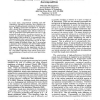Free Online Productivity Tools
i2Speak
i2Symbol
i2OCR
iTex2Img
iWeb2Print
iWeb2Shot
i2Type
iPdf2Split
iPdf2Merge
i2Bopomofo
i2Arabic
i2Style
i2Image
i2PDF
iLatex2Rtf
Sci2ools
AAAI
1996
1996
Building Steady-State Simulators via Hierarchical Feedback Decomposition
In recent years, compositional modeling and selfexplanatory simulation techniques have simplified the process of building dynamic simulators of physical systems. Building steady-state simulators is, conceptually, a simpler task consisting in solving a set algebraic equations. This simplicity hides delicate technical issues of convergence and search-space size due to the potentially large number of unknown parameters. We present an automated technique for reducing the dimensionality of the problem by 1) automatically identifying feedback loops (a generally NP-complete problem), 2) hierarchically decomposing the set of equations in terms of feedback loops, and 3) structuring a simulator where equations are solved either serially without search or in isolation within a feedback loop. This paper describes the key algorithms and the results of their implementation on building simulators for a two-phase evaporator loop system across multiple combinations of causal and non-causal approximati...
| Added | 02 Nov 2010 |
| Updated | 02 Nov 2010 |
| Type | Conference |
| Year | 1996 |
| Where | AAAI |
| Authors | Nicolas F. Rouquette |
Comments (0)

